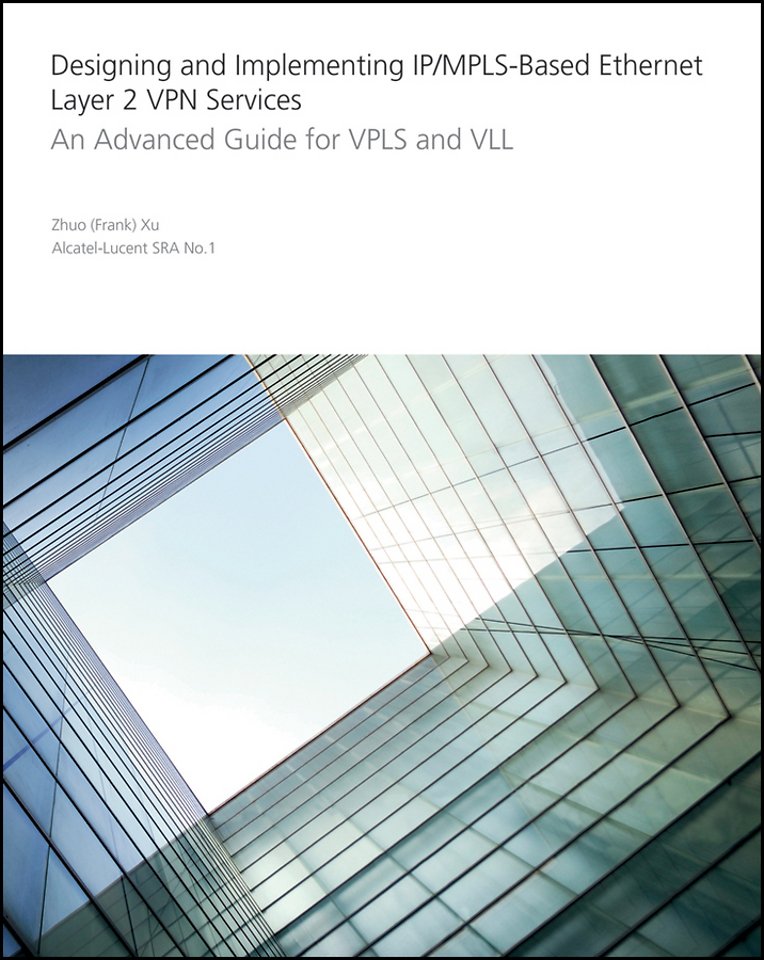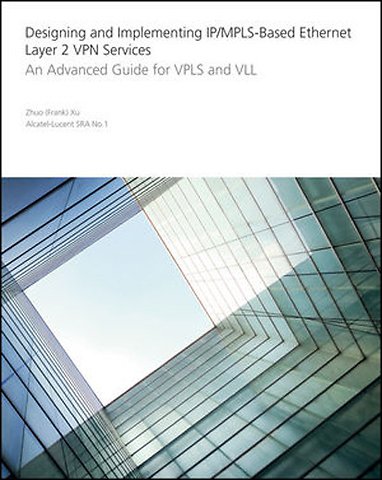


Zhuo (Frank) Xu is a recognized MPLS/VPLS service routing expert. A seasoned telecom professional, he holds several industry IP certifications including the distinction of being the world's first Alcatel-Lucent Service Routing Architect.
Meer over de auteursDesigning and Implementing IP/MPLS-Based Ethernet Layer 2 VPN Services
An Advanced Guide for VPLS and VLL
Samenvatting
'Designing and Implementing IP/MPLS-Based Ethernet Layer 2 VPN Services' is a must read for any network engineer interested in IP/MPLS technologies and Carrier Ethernet Layer 2 VPN services. Discover what it takes to optimize an IP/MPLS-based VPN network's reliability, performance, and flexibility.
Learn about the core components of an IP/MPLS VPN Service Architecture, and enhance your network with new service-carrying IP/MPLS technologies such as RSVP-TE, Fast Reroute, and secondary LSP. Get a thorough knowledge of the two core Ethernet Layer 2 VPN services: Virtual Private LAN Service (VPLS) and Virtual Leased Line (VLL). Explore advanced topics such as Service Resiliency, BGP Auto-discovery, Provider Backbone Bridging, and OAM for VPLS and learn how to implement them in your network.
Specificaties
Inhoudsopgave
U kunt van deze inhoudsopgave een PDF downloaden
Introduction.
Part 1: IP/MPLS VPN Service Network Overview.
1. Building Converged Service Networks with IP/MPLS VPN Technology.
1.1 The Increasing Demands on Service Provider Networks.
1.2 MPLS Overview.
1.3 The MPLS Value Proposition.
1.4 MPLS Enables Converged Multi-Service Networks.
1.5 MPLS-Enabled Business VPN Services.
Summary.
2. IP/MPLS VPN Multi-Service Network Overview.
2.1 IP/MPLS Layer 2 VPN Requirements.
2.2 IP/MPLS Layer 2 VPN Services.
2.3 Meeting the Service Network Requirements Using IP/MPLS VPN Architecture.
2.4 IP/MPLS VPN-Enabled Applications.
Summary.
Part 2: IP/MPLS VPN Protocol Fundamentals.
3. Using MPLS Label Switched Paths as Service Transport Tunnels.
3.1 Basic MPLS Concepts Review.
3.2 Label Switch Path Types.
3.3 LDP-LSP — LDP Label Distribution.
3.4 RSVP-TE LSPs.
3.5 Confi guring RSVP-TE LSP.
Summary.
4. Routing Protocol Traffi c Engineering and CSPF.
4.1 Introducing Traffi c Engineering.
4.2 Introducing OSPF-TE.
4.3 Introducing IS-IS TE.
4.4 The CSPF Algorithm.
4.5 RSVP-TE LSP Policy Control: Administrative Groups and SRLG Groups.
Summary.
5. RSVP-TE Protocol.
5.1 RSVP and RSVP-TE.
5.2 RSVP-TE Signaling Procedure.
5.3 RSVP-TE Messages and Objects.
5.4 Make-Before-Break (MBB).
5.5 The RSVP-TE Hello Protocol.
5.6 Reducing RSVP Refresh Overhead.
5.7 RSVP MD5 Authentication.
Summary.
6. MPLS Resiliency — Secondary LSP.
6.1 Ensuring Reliability with MPLS Resiliency.
6.2 An Overview of Primary and Secondary LSPs.
6.3 What Affects Convergence Performance?
6.4 Rules for Selecting Secondary LSPs.
6.5 Case Study: Using Administrative Groups in Secondary LSPs.
Summary.
7. MPLS Resiliency — RSVP-TE LSP Fast Reroute.
7.1 RSVP-TE LSP Resiliency.
7.2 Fast Reroute Overview.
7.3 Fast Reroute Architecture.
7.4 One-to-One Backup.
7.5 Facility Backup.
7.6 Manual Bypass Tunnel.
Summary.
8. Label Distribution Protocol.
8.1 LDP Overview.
8.2 LDP Session Establishment and Management.
8.3 Using T-LDP to Signal Pseudowires for Layer 2 VPN Services.
8.4 LDP Messages and TLVs.
8.5 LDP over RSVP-TE Tunneling.
Summary.
Part 3: Ethernet VPN Services.
9. IP/MPLS VPN Service Routing Architecture.
9.1 IP/MPLS VPN Service Network Infrastructure.
9.2 Alcatel-Lucent Service Routing Architecture.
9.3 Service Access Point and SAP Components.
9.4 Service Distribution Paths and Transport Tunnels.
9.5 Multiple Forwarding Paths in the Same SDP.
9.6 Maximum Transmission Unit in a Service Network.
9.7 IP/MPLS VPN Service Implementation Overview.
Summary.
10. Virtual Leased Line Services.
10.1 VLL Services Overview.
10.2 VLL Services Architecture.
10.3 Pseudowire Switching for VLL Services.
10.4 VLL Example: Epipe — Ethernet P2P VPN.
10.5 VLL Connection Admission Control.
Summary.
11. Virtual Private LAN Service.
11.1 VPLS Service Overview.
11.2 VPLS Architecture.
11.3 VPLS Mesh-Pseudowires.
11.4 VPLS Service Access Points.
11.5 VPLS Forwarding Database Management.
Summary.
12. Hierarchical VPLS.
12.1 Hierarchical-VPLS Overview.
12.2 Spoke-Pseudowire Details.
12.3 H-VPLS Topologies.
12.4 H-VPLS Design Case Study — Where to Break the Mesh?
Summary.
13. High Availability in an IP/MPLS VPN Network.
13.1 Building a Network with High Availability.
13.2 Bidirectional Forwarding Detection.
13.3 Link Aggregation Group Overview.
13.4 Multi Chassis Link Aggregation Group.
13.5 Traffi c Load Balancing in Link Aggregation Groups.
Summary.
14. VLL Service Resiliency.
14.1 VLL Service Resiliency Overview.
14.2 VLL Service Resiliency Using Pseudowire Redundancy.
14.3 VLL Network Design Using MC-LAG with Pseudowire Redundancy.
Summary.
15. VPLS Service Resiliency.
15.1 Introduction to VPLS Service Resiliency.
15.2 Access Resiliency.
15.3 H-VPLS Backbone Resiliency.
15.4 Using MAC-Flush to Avoid Blackholes.
Summary.
Part 4: Advanced Ethernet VPN Topics.
16. VPLS BGP Auto-Discovery.
16.1 VPLS BGP-AD Overview.
16.2 BGP Auto-Discovery for LDP-VPLS.
16.3 SDPs, Transport Tunnels, and Pseudowires Created Using BGP-AD.
16.4 Using Pre-Provisioned SDPs.
16.5 Using BGP-AD Import and Export Policies to Control the Forwarding Topology of VPLS.
Summary.
17. PBB-VPLS.
17.1 Provider Backbone Bridge Overview.
17.2 PBB-VPLS Architecture.
17.3 PBB-VPLS Learning and Forwarding.
17.4 Controlling Flooding in PBB-VPLS.
17.5 FDB Management in I-VPLS and B-VPLS.
17.6 OAM in a PBB-VPLS Network.
17.7 Service Resiliency in PBB-VPLS Networks.
17.8 MAC-Flush in PBB-VPLS.
17.9 PBB Epipe.
Summary.
18. OAM in a VPLS Service Network.
18.1 OAM Functional Overview.
18.2 Ethernet in the First Mile (EFM) OAM (802.3ah).
18.3 Ethernet Connectivity Fault Management.
18.4 OAM in an IP/MPLS VPN Service Network.
18.5 OAM in VPLS Services.
Summary.
Appendix A: Spanning Tree Protocol.
A.1 Spanning Tree Protocol.
A.2 Spanning Tree Protocol Variations.
A.3 VPLS Service Loop Prevention with STP.
A.4 Altered STP Behavior in the VPLS Core.
A.5 Using VPLS STP to Eliminate Customer Forwarding Loops.
A.6 Using VPLS STP to Block Redundant Spoke-Pseudowires in H-VPLS.
A.7 LDP MAC-Flush in STP Convergence.
A.8 Management VPLS.
Appendix B: RFC and IEEE Standards.
Glossary.
Index
Anderen die dit boek kochten, kochten ook
Net verschenen
Rubrieken
- aanbestedingsrecht
- aansprakelijkheids- en verzekeringsrecht
- accountancy
- algemeen juridisch
- arbeidsrecht
- bank- en effectenrecht
- bestuursrecht
- bouwrecht
- burgerlijk recht en procesrecht
- europees-internationaal recht
- fiscaal recht
- gezondheidsrecht
- insolventierecht
- intellectuele eigendom en ict-recht
- management
- mens en maatschappij
- milieu- en omgevingsrecht
- notarieel recht
- ondernemingsrecht
- pensioenrecht
- personen- en familierecht
- sociale zekerheidsrecht
- staatsrecht
- strafrecht en criminologie
- vastgoed- en huurrecht
- vreemdelingenrecht





